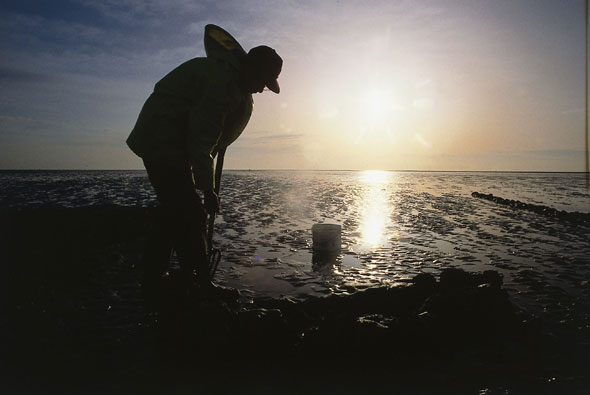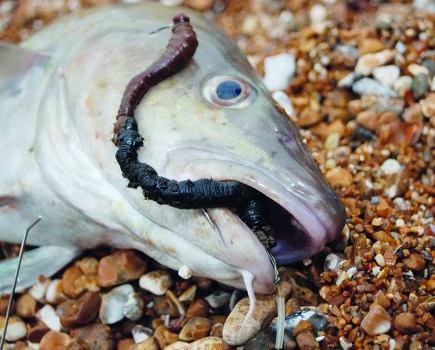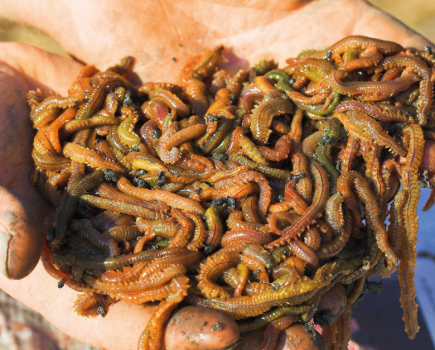During most of the year, basic bait like lugworms are readily available, but in the depths of winter they are in short supply, so don’t be disappointed when your local tackle dealer shakes his head and says: “Sorry, squire, the weather is atrocious and I just can’t get bait.”
This sort of depressing news just might make you consider setting up a bait fridge so that it will be ready for the imminent flush of spring and that superb bait, peeler crabs.
All anglers need bait and supplies are usually available from tackle dealers, but lots of fishermen find that they can manage their own bait supplies more efficiently with a small domestic fridge, or fridge freezer.
A bait fridge is a valuable aid to the angler because it can be used to prolong the life of live and frozen bait from times when bait is plentiful to periods of shortage.
An ever-ready bait supply also allows the angler to take advantage of an influx of fish or favourable weather conditions – you can go fishing instantly without having to rely on a tackle dealer for your bait supplies.
Most sea anglers use an old domestic fridge to store bait, but a fridge-freezer may be a better buy because it enables you to store both fresh and frozen bait and make the most of limited room, although you could have a separate fridge and freezer.
Unwanted fridges and freezers can be picked up in the local small ads for as little as £5 and in lots of cases the seller is just keen to get shot of an old fridge or freezer when they upgrade.
Obviously, the fridge has to be in good working order and it’s a good idea to get assurances from the seller that it actually works! Check that door seals fit snug and, if the fridge is running, check that the thermostat works by altering the setting, listen for it to click on and off.
If the ice box or drip tray is full of ice then there is a good chance the fridge has a faulty thermostat or has been neglected. Look for pools of water under the fridge, if you see any don’t buy. Watch for rusted casings too.
Setting up your ‘bait station’
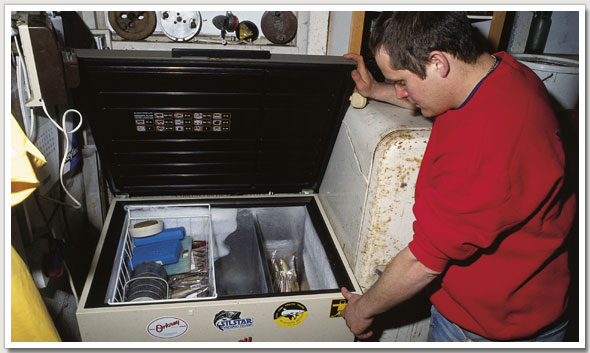
Position the fridge with some thought, first choice is an outhouse or garage. Bait storage involves some pretty obnoxious smells no matter how careful you are, so keep away from delicate noses.
Avoid positions close to radiators or where the fridge is likely to be influenced by heat, sunlight or cold weather.
Amajor problem with a bait fridge is saltwater spillage from worm trays etc, which cannot be avoided. Saltwater wreaks havoc with the lightweight steel most fridges are constructed from, so look for plastic-coated shelves and a large salad tray that will catch spills.
Fridges with a small built-in freezer compartment are ideal for storing live bait because the colder section at the top of the fridge near the freezer compartment offers a greater range of temperature inside the fridge. That’s handy for storing and controlling the speed peeler crabs shed their shells.
Here’s what you can store in a fridge
When lugworms are in good supply there is no need to fridge them, but in the depth of winter, when supplies are unpredictable, then lugworms dug in better weather or during the more productive spring tides can be kept for a week.
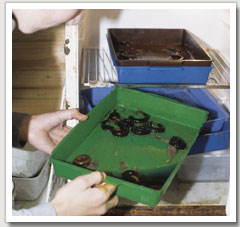 LUGWORMS – Will keep alive and reasonably fresh for up to a week in dry newspaper. For longer periods they can be “tanked” in seawater, although this is said to wash the worms out and make them less effective as bait. However, they remain a better bait than no worms at all.
LUGWORMS – Will keep alive and reasonably fresh for up to a week in dry newspaper. For longer periods they can be “tanked” in seawater, although this is said to wash the worms out and make them less effective as bait. However, they remain a better bait than no worms at all.
Common lugworms are best wrapped in packets of 20 (a score) in a minimum of three layers of newspaper, but beware placing packets on top of each other.
An alternative is to place them in a cat litter tray in a dribble of seawater; this also applies to live yellowtails.
Don’t submerge worms because this allows bacteria to spread quickly and dead worms to kill live ones. The worms don’t have to swim, just be kept wet.
Tougher yellowtails or black lugworms can also be wrapped in newspaper, although they are more often placed in “rolls” of ten. Double over a single sheet of newspaper and place the worms at intervals in the paper as you roll it up, then wrap rolls in scores.
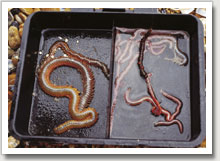 RAGWORMS – Can be kept alive fairly easily in a shallow tray with a dribble of seawater, but limit worms to ten per tray. For storage in newspaper, damp sea peat is ideal because it keeps the ragworms moist. An alternative is garden peat wetted with seawater with 20 worms to a packet.
RAGWORMS – Can be kept alive fairly easily in a shallow tray with a dribble of seawater, but limit worms to ten per tray. For storage in newspaper, damp sea peat is ideal because it keeps the ragworms moist. An alternative is garden peat wetted with seawater with 20 worms to a packet.
Vermiculite roof insulation material dries ragworms out and is an efficient way to keep them for several days when a fridge is not available.
When worms are wrapped in newspaper, don’t let water or damp get to the worms. Place packets or rolls in a sealed plastic bag and also renew newspaper if it does become damp. Dampness can often be caused by a full drip tray or that the fridge needs defrosting.
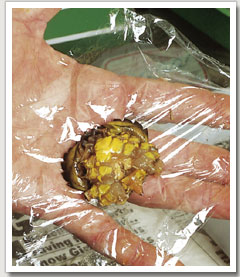 PEELER CRABS – The speed at which peeler crabs shed their shell can be controlled in a fridge. To keep them in prime condition at a time when they are just about to shed their shell they must be kept moist. Asmall spray of seawater kept at fridge temperature is ideal for this.
PEELER CRABS – The speed at which peeler crabs shed their shell can be controlled in a fridge. To keep them in prime condition at a time when they are just about to shed their shell they must be kept moist. Asmall spray of seawater kept at fridge temperature is ideal for this.
Crabs can be frozen, but they must be alive when they are peeled and frozen as quickly as possible. Wash under the tap and wrap in foil or cling film and then freeze as quickly as possible.
SQUID – The lazy man’s bait – just freeze it. Like all frozen bait, once thawed they lose their freshness. As a rule don’t return thawed bait to the freezer. The exception is shellfish which fish are used to finding in a smelly state of decay. Razorfish, piddock clams etc actually work better slightly rotten.
FISH BAIT – Remain fresh for a couple of days, otherwise freeze.
SANDEELS – Need lots of air supplied by a pump and stone to keep them alive. A superb frozen bait.
Fridge tips
- The perfect bait fridge is the large commercial drinks cooler with a see through door. Hard to come by they offer easy access, maximum capacity and the perfect temperature range for live worms!
- A thin sheet of polystyrene can be used to protect or separate delicate bait stored in trays from low temperatures.
- Cat litter trays and shallow boxes that slot into one another allow lots of bait to be stored in a small space. Check out DIY stores.
- Always freeze bait in small amounts, mark with date so that supplies can be rotated.
- Check your fridge daily and remove dead or dying worms immediately. Keep spare clean saltwater in your fridge so it’s at the same temperature as stored bait.
- If you are also a coarse angler, beware of keeping maggots in a sea bait fridge.

